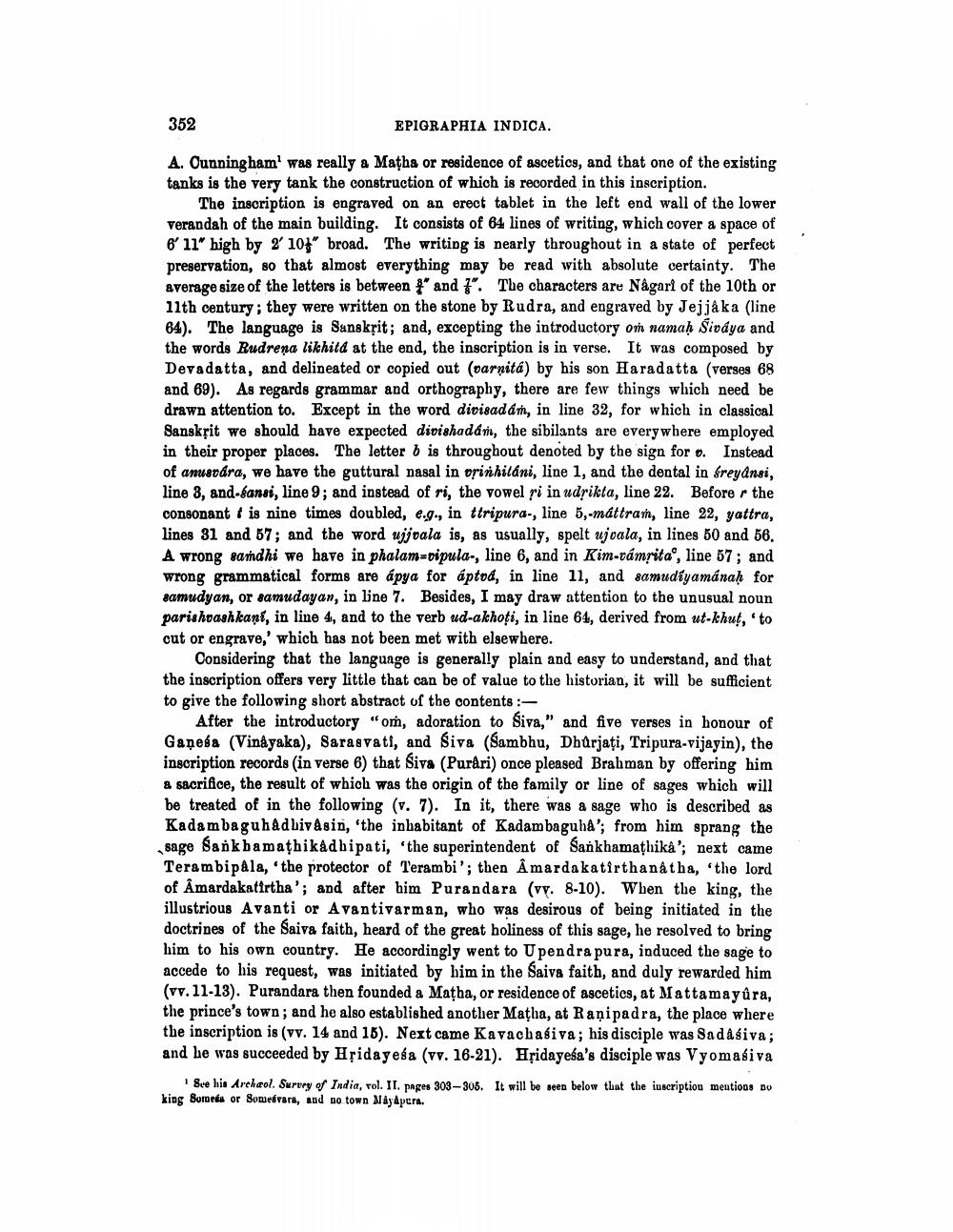________________
352
EPIGRAPHIA INDICA.
A. Cunningham' was really a Matha or residence of ascetics, and that one of the existing tanks is the very tank the construction of which is recorded in this inscription.
The inscription is engraved on an erect tablet in the left end wall of the lower verandah of the main building. It consists of 64 lines of writing, which cover a space of 6' 11" high by 2 103" broad. The writing is nearly throughout in a state of perfect preservation, so that almost everything may be read with absolute certainty. The average size of the letters is between f* and ". The characters are Någari of the 10th or 11th century; they were written on the stone by Rudra, and engraved by Jejja ka (line 64). The language is Sanskrit; and, excepting the introductory om namah Sivaya and the words Rudrena likhita at the end, the inscription is in verse. It was composed by Devadatta, and delineated or copied out (varnitá) by his son Haradatta (verses 68 and 69). As regards grammar and orthography, there are few things which need be drawn attention to. Except in the word divisadam, in line 32, for which in classical Sanskrit we should have expected didishadám, the sibilants are everywhere employed in their proper places. The letter b is throughout denoted by the sign for ". Instead of anusvára, we have the guttural nasal in orinhilani, line 1, and the dental in Sreyansi, line 3, and-lansi, line 9; and instead of ri, the vowel ri in udrikta, line 22. Before r the consonant ( is nine times doubled, e.g., in ttripura-, line 5,-máttran, line 22, yattra, lines 31 and 57; and the word ujjvala is, as usually, spelt ujvala, in lines 50 and 56. A wrong sandhi we have in phalam=vipula-, line 6, and in Kim-rámrita", line 57; and wrong grammatical forms are apya for áptod, in line 11, and samudiyamanah for samudyan, or samudayan, in line 7. Besides, I may draw attention to the unusual noun parishvashkani, in line 4, and to the verb ud-akhoti, in line 64, derived from ut-khut, to cut or engrave,' which has not been met with elsewhere.
Considering that the language is generally plain and easy to understand, and that the inscription offers very little that can be of value to the historian, it will be sufficient to give the following short abstract of the contents :
After the introductory "om, adoration to Siva," and five verses in honour of Ganesa (Vinayaka), Sarasvati, and Siva (Sambhu, Dharjati, Tripura-vijayin), the inscription records (in verse 6) that Siva (Purari) once pleased Brahman by offering him & sacrifice, the result of which was the origin of the family or line of sages which will be treated of in the following (v. 7). In it, there was a sage who is described as Kadambaguhad bivsin, 'the inhabitant of Kadam baguha'; from him sprang the sage Sankbamathikadhipati, 'the superintendent of Sankhamathika'; next came Terambipala, 'the protector of Terambi'; then Amardakatirthanatha, the lord of Amardakatirtha'; and after him Purandara (vv. 8-10). When the king, the illustrious Avanti or Avantivarman, who was desirous of being initiated in the doctrines of the Saiva faith, heard of the great holiness of this sage, he resolved to bring him to his own country. He accordingly went to Upendra pura, induced the sage to accede to his request, was initiated by him in the Saiva faith, and duly rewarded him (vv. 11-13). Purandara then founded a Matha, or residence of ascetics, at Mattamayûra, the prince's town; and he also established another Matha, at Ranipadra, the place where the inscription is (vv. 14 and 16). Next came Kavachasiva; his disciple was Sadasiva; and he was succeeded by Hșidayesa (vv. 16-21). Hridayeśa's disciple was Vyomasiva
Sve his Archæol. Survey of India, vol. II. pages 303-305. king some or Someswara, and no town Máydpera.
It will be seen below that the inscriptiou mentions by




